
XiaoXinAir14IML_2019_hackintosh
小新Air14 2019款 i5 10210u黑苹果
Stars: 140
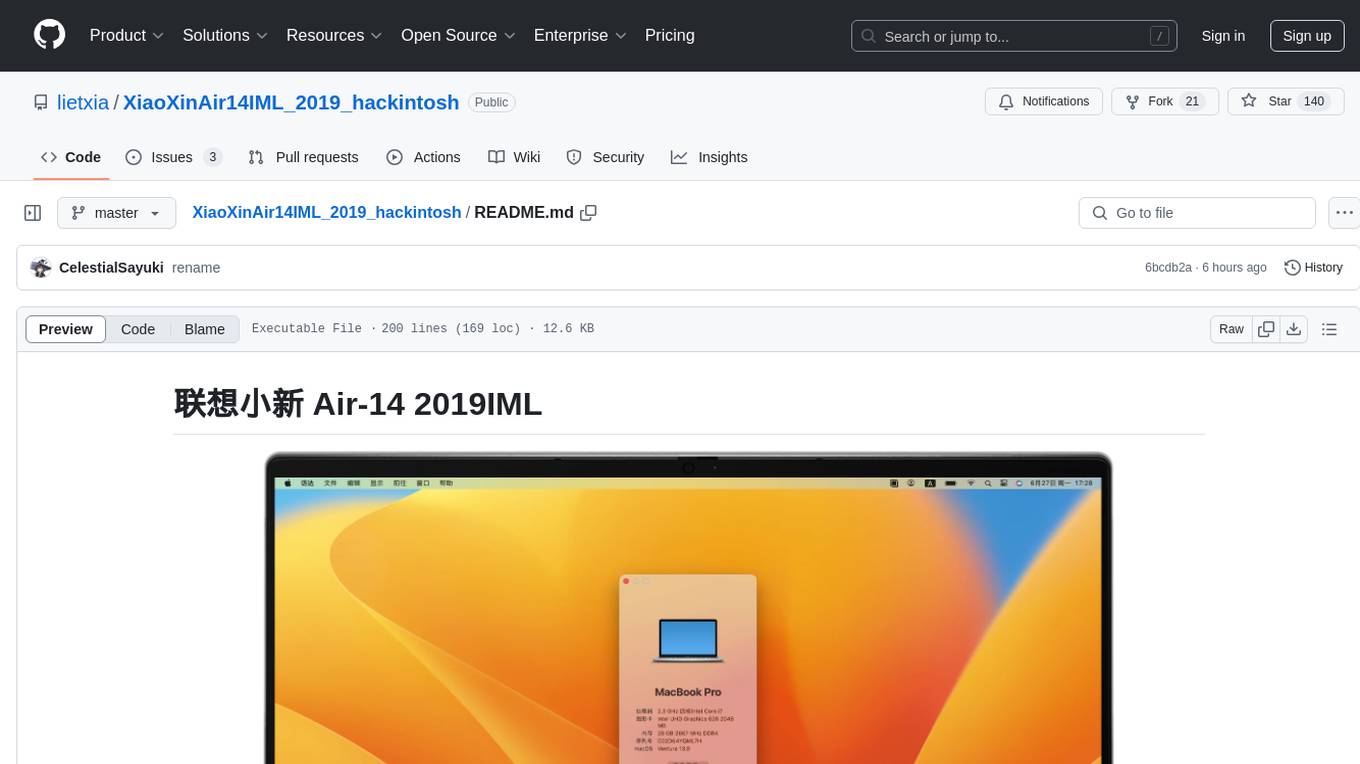
XiaoXinAir14IML_2019_hackintosh is a repository dedicated to enabling macOS installation on Lenovo XiaoXin Air-14 IML 2019 laptops. The repository provides detailed information on the hardware specifications, supported systems, BIOS versions, related models, installation methods, updates, patches, and recommended settings. It also includes tools and guides for BIOS modifications, enabling high-resolution display settings, Bluetooth synchronization between macOS and Windows 10, voltage adjustments for efficiency, and experimental support for YogaSMC. The repository offers solutions for various issues like sleep support, sound card emulation, and battery information. It acknowledges the contributions of developers and tools like OpenCore, itlwm, VoodooI2C, and ALCPlugFix.
README:
 截图软件:capXDR
截图软件:capXDR
模板:Lenovo-Air14IML
QQ群号:1032311345
中文
ENGLISH
| 规格 | 状态 | 详细信息 |
|---|---|---|
| 型号💻 | ✅ | Lenovo XiaoXin Air14 IML 2019 |
| 系统🌌 | ✅ | Catalina/Big Sur/Monterey/Ventura/Sonoma |
| CPU🎛️ | ✅ | Intel Core i5-10210U / i7-10510U |
| 主板🎛️ | ✅ | Lenovo LNVNB161216 |
| 指纹🖐️ | ⛔ | 指纹无法工作 |
| GPU👾 | ⛔ | Nvidia GeForce MX250(屏蔽) |
| iGPU👾 | ✅ | Intel UHD 620 |
| 内存💳 | ✅ | 内置4GB+可更换的32GB DDR4 2666 |
| 硬盘💽 | ✅ | 见 Benchmarks/Disks |
| 屏幕🖥️ | ✅ | AUO353D/LGD05EC(14英寸) 1920x1080 60~75Hz(超频) |
| 声卡🔊 | ✅ | Conexant CX8070 |
| wifi🌐 | ✅ | Intel Wireless-AC 9560/DW1820A |
| 蓝牙🦷 | ✅ | Intel Wireless-AC 9560/DW1820A |
| 读卡器🗂️ | ✅ | O2 Micro 读卡器(可驱动) / Realtek 读卡器(可驱动) |
| 触摸板🖐️ | ✅ | 已运行在GPIO中断 Pin=50 |
| HDMI📺 | ✅ | 可输出4k30帧,和win表现一致 |
| 摄像头🎦 | ✅ | USB摄像头还是很好驱动的 |
| 睡眠😴 | ✅ | 支持原生睡眠 |
- 系统🌌:Catalina / BigSur / Monterey / Ventura / Sonoma
- 硬盘:如果你硬盘是三星PM981A,建议换掉。
- 声卡🔊:仿冒layout-id 15成功,无爆音 耳麦一体耳机需要这个
- 小新Pro13(i5-10210U / i7-10710U)
- 小新13IML
- 小新air13IWL(i5-8265U / i7-8565U)
- 小新air15IKBR(i5-8265U)
- 小新air14(i5-1035G1)
- 小新air14(i7-1065G7)
- 小新air15(i5-1035G1)
- 小新air15(i5-10210U)
- Lenovo-Ideapad-S540-15IML(i5-10210U)
- Lenovo-Ideapad-S540-15IML(i5-10210U)
- Lenovo-Ideapad-S540-15IWL(i5-8265U)
- Lenovo-Ideapad-S540-14IML(i5-10210U)
- Lenovo-Ideapad-S540-14IWL(i5-8265U)
- Lenovo-Ideapad-S540-14IML (i5-10210U / i7-10510U)
https://newsupport.lenovo.com.cn/driveDownloads_detail.html?driveId=78312
展开查看
2022/05/13 BIOS Version: CKCN19WW http://newdriverdl.lenovo.com.cn/newlenovo/alldriversupload/94976/BIOS-CKCN19WW.exe2022/03/18 BIOS Version: CKCN18WW http://newdriverdl.lenovo.com.cn/newlenovo/alldriversupload/92231/BIOS-CKCN18WW.exe
2021/07/23 BIOS Version: CKCN17WW http://newdriverdl.lenovo.com.cn/newlenovo/alldriversupload/83713/BIOS-CKCN17WW.exe
2021/01/18 BIOS Version: CKCN16WW http://newdriverdl.lenovo.com.cn/newlenovo/alldriversupload/78312/BIOS-CKCN16WW.exe
2020/07/24 BIOS Version: CKCN15WW http://newdriverdl.lenovo.com.cn/newlenovo/alldriversupload/73409/BIOS-CKCN15WW.exe
2020/06/22 BIOS Version: CKCN14WW http://newdriverdl.lenovo.com.cn/newlenovo/alldriversupload/72386/BIOS-CKCN14WW.exe
2019/12/16 BIOS Version: CKCN12WW http://newdriverdl.lenovo.com.cn/newlenovo/alldriversupload/67169/BIOS-CKCN12WW.exe
2019/08/08 BIOS Version: CKCN11WW http://newdriverdl.lenovo.com.cn/newlenovo/alldriversupload/60449/BIOS-CKCN11WW.exe
https://newsupport.lenovo.com.cn/driveDownloads_detail.html?driveId=77695
展开查看
2021/07/23 Version: CKME05WW http://newdriverdl.lenovo.com.cn/newlenovo/alldriversupload/83714/FW-CKME05WW.exe2020/12/17 Version: CKME03WW http://newdriverdl.lenovo.com.cn/newlenovo/alldriversupload/77695/FW-CKME03WW.exe
2020/06/23 Version: CKME02WW http://newdriverdl.lenovo.com.cn/newlenovo/alldriversupload/72429/ME-CKME02WW.exe
2019/12/16 Version: CKME01WW http://newdriverdl.lenovo.com.cn/newlenovo/alldriversupload/67174/FW-CKME01WW.exe
-
2024-05-26 10:30
- 支持macOS Somoma 14.4+
- 更新Opencore和Kexts.
-
历史修改记录见changelog.md
- 如果你使用openCore,BIOS请使用1.0.2之外的版本 (1.0.2需要关掉超线程才能使用oc)
- 改BIOS设置(推荐和必须的地方必须改) https://github.com/lietxia/XiaoXinAir14IML_2019_hackintosh/wiki/bios
- 改DVMT和 CFG Lock(见后文,推荐做)
- 下载balenaEtcher,用它写入:2022-06-19-XiaoXinAir14IML-4in1-installerV7.dmg(提取码:q27r)
- 引导写入的镜像的第二个EFI分区,选择需要安装的系统即可。
- 【防止黑苹果间歇性断网-解决方案 感谢@Unstoppablesss】修改 系统偏好设置/节能/电源适配器/如果可能,使硬盘进入睡眠(修改为off)
- 因目前休眠无法正常唤醒 , 为避免影响到睡眠 , 终端使用命令关闭休眠
sudo pmset -a hibernatemode 0
- 用途:降压获得更高能效,可以显著降低温度或提升一定功耗下的性能(约50%)
- 方法:
- 1.遵循BIOS_UnlockOCPM的指示解开超频菜单
极度危险,务必备份BIOS - 2.打开
Advanced→Overclocking Performance Menu→Overclocking Feature→Enabled - 3.在macOS中使用VoltageShift进行修改
- 1.遵循BIOS_UnlockOCPM的指示解开超频菜单
- 正常的:风扇三种模式切换、麦克风静音、飞行模式、F10切换屏幕、触摸板开关有提示、键盘背光、Fn功能键切换
- 不正常:摄像头有提示,但是关不掉、锁定功能用不了、Fn+Q不能修改、拔插电源会错误显示键盘背光、电池温度读不出来、不能调整充电速度
https://github.com/lietxia/BT-LinkkeySync
bash -c "$(curl -fsSL https://raw.githubusercontent.com/xzhih/one-key-hidpi/dev/hidpi.sh)"
bash -c "$(curl -fsSL https://raw.githubusercontent.com/xzhih/one-key-hidpi/master/hidpi.sh)"
https://www.dell.com/support/home/zh-cn/drivers/driversdetails?driverid=98wfd
必须解锁
CFG Lock不然无法使用opencore clover。
建议解锁DVMT让显存大小变成64M,没有什么坏处。
-
推荐方法: 进隐藏BIOS
- BIOS里的
onekeybattery需要关闭,才能进隐藏BIOS - 隐藏BIOS进入姿势
- 电源键开机 → F2进入正常BIOS → 电源键关机 → 然后顺序按下下列键
-
F4→4→R→F→V -
F5→5→T→G→B -
F6→6→Y→H→N - 电源键开机 → F2进入隐藏BIOS , 如不成功请加快手速再次尝试
- 推荐设置选项
-
Advanced→Power & Performance→CPU - Power Management Control→CPU Lock Configuration→CFG Lock→Disabled -
Advanced→System Agent (SA) Configuration→Graphics Configuration→DVMT Pre-Allocated→64M
-
- BIOS里的
-
备用方法: windows直接改
-
参考 https://github.com/lietxia/XiaoXinAir14IML_2019_hackintosh/wiki/DVMT
-
DVMT:- 区域(area) :
SaSetup - 偏移(offset) :
0x107 -
01to02
- 区域(area) :
-
CFG LOCK:- 区域(area) :
CpuSetup - 偏移(offset) :
0x3E -
01to00
- 区域(area) :
-
- 用途:增加M系列独占的高级地图功能
- 方法:运行/macforge/install.command
- 截图键(PrintScreen PrtSC)在mac下是不能用的,我把他映射到F13,自己把截图快捷键改到F13即可(系统偏好设置-键盘-快捷键-截屏)
| 补丁 | 说明 | 必备 | 建议 | 可选 |
|---|---|---|---|---|
| SSDT-SBUS-MCHC.aml | SBUS + MCHC | √ | ||
| SSDT-EC-USBX.aml | EC+USBX | √ | ||
| SSDT-TPAD-Air14IML | I2C触摸板补丁(AIR14IML专用) | √ | ||
| SSDT-DMAC | 仿冒 DMA 控制器 | √ | ||
| SSDT-GPRW | 防秒醒:0D / 6D 睡了即醒补丁 | √ | ||
| SSDT-PMC | PMC 设备 | √ | ||
| SSDT-HPTE | 屏蔽 HPET 补丁 | √ | ||
| SSDT-PNLFCFL | Coffee Lake 亮度控制补丁 | √ | ||
| SSDT-PR00 | (X86)CPU电源管理补丁(开启XCPM) | √ | ||
| SSDT-RMCF-Air14IML | PS2 按键映射补丁 | √ | ||
| SSDT-UIAC | 定制USB | √ | ||
| SSDT-BATX-Air14IML | 电池附加信息 | √ | ||
| SSDT-AWAC | “伪” RTC时钟 | √ | ||
| SSDT-ECRW | yogaSMC的EC访问补丁 | √ |
- 拆机需要6号的6角螺丝刀。螺丝拿下来之后,用不用的银行卡,慢慢从屏幕那一侧慢慢拆开 https://www.bilibili.com/video/BV1X341157kf/
- 如果要买【圆口转USB type转接器】,注意【圆口直径4毫米,孔直径1.7毫米】

- Acidanthera 开发的 OpenCore 和 其他驱动
- Apple 开发的 macOS
- lietxia 维护EFI
- zxystd 开发的 itlwm
- Bat.bat 开发的 IntelBluetoothFirmware 和 HeliPort
- alexandred 开发的 VoodooI2C
- athlonreg 开发的 ALCPlugFix 来修复耳麦一体耳机的问题
- Celestial紗雪 翻译英文readme并制作AIO版本EFI
- sun19970908 提供ALC节点,修改ALCPlugFix并测试CPUFriend
- stevezhengshiqi 开发的 one-key-cpufriend
- SoMeone 破解的隐藏 BIOS
- mandresve 对O2读卡器的支持和Voltageshift超频的启用和测试。
- PoomSmart 开发的 AdvancedMapEnabler
- MacEnhance 开发的 MacForge
For Tasks:
Click tags to check more tools for each tasksFor Jobs:
Alternative AI tools for XiaoXinAir14IML_2019_hackintosh
Similar Open Source Tools

XiaoXinAir14IML_2019_hackintosh
XiaoXinAir14IML_2019_hackintosh is a repository dedicated to enabling macOS installation on Lenovo XiaoXin Air-14 IML 2019 laptops. The repository provides detailed information on the hardware specifications, supported systems, BIOS versions, related models, installation methods, updates, patches, and recommended settings. It also includes tools and guides for BIOS modifications, enabling high-resolution display settings, Bluetooth synchronization between macOS and Windows 10, voltage adjustments for efficiency, and experimental support for YogaSMC. The repository offers solutions for various issues like sleep support, sound card emulation, and battery information. It acknowledges the contributions of developers and tools like OpenCore, itlwm, VoodooI2C, and ALCPlugFix.
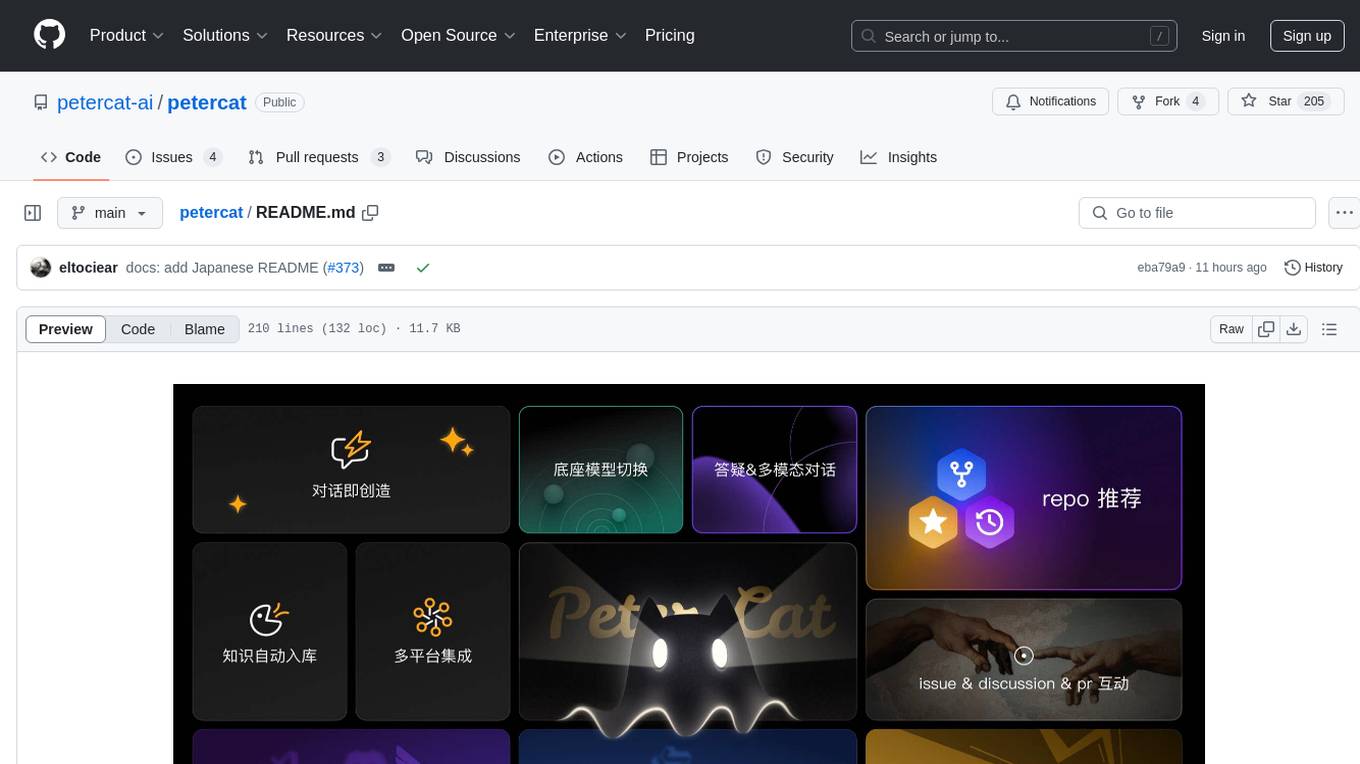
petercat
Peter Cat is an intelligent Q&A chatbot solution designed for community maintainers and developers. It provides a conversational Q&A agent configuration system, self-hosting deployment solutions, and a convenient integrated application SDK. Users can easily create intelligent Q&A chatbots for their GitHub repositories and quickly integrate them into various official websites or projects to provide more efficient technical support for the community.
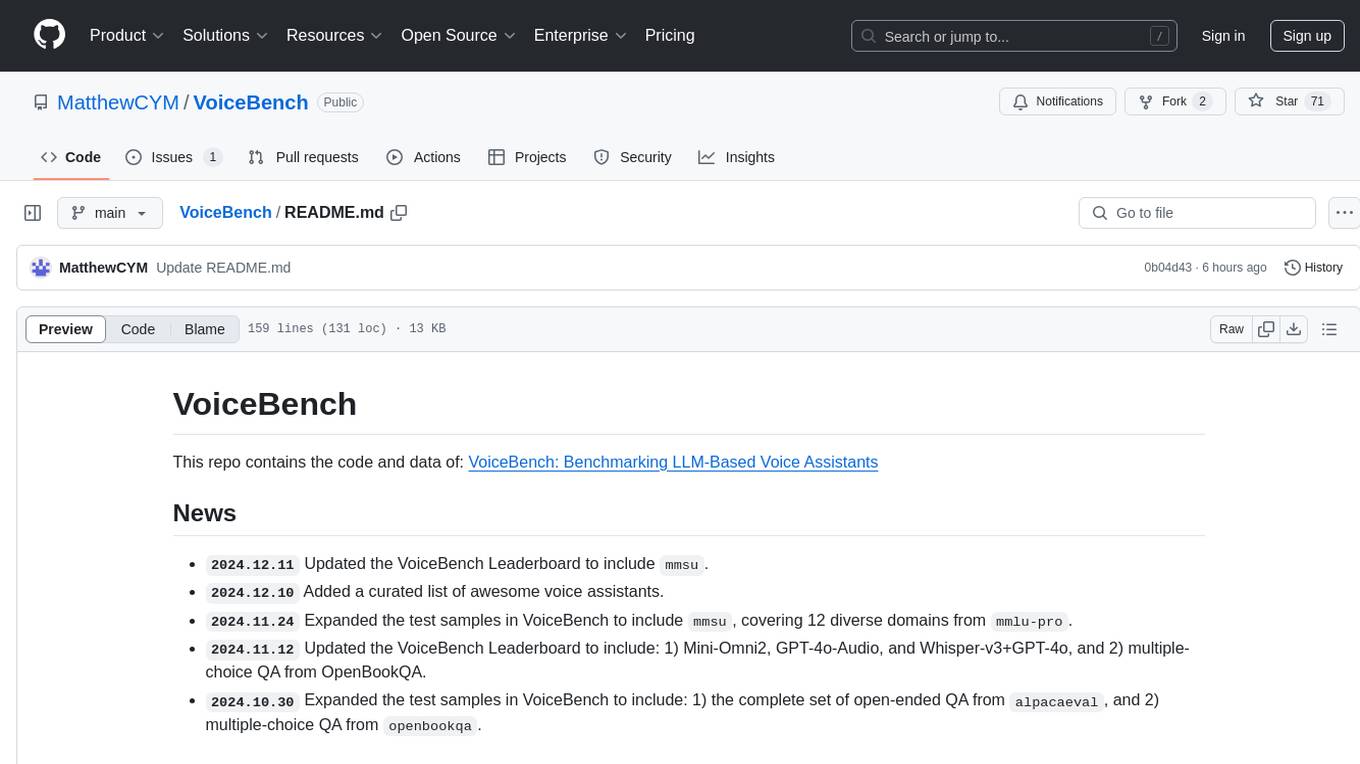
VoiceBench
VoiceBench is a repository containing code and data for benchmarking LLM-Based Voice Assistants. It includes a leaderboard with rankings of various voice assistant models based on different evaluation metrics. The repository provides setup instructions, datasets, evaluation procedures, and a curated list of awesome voice assistants. Users can submit new voice assistant results through the issue tracker for updates on the ranking list.
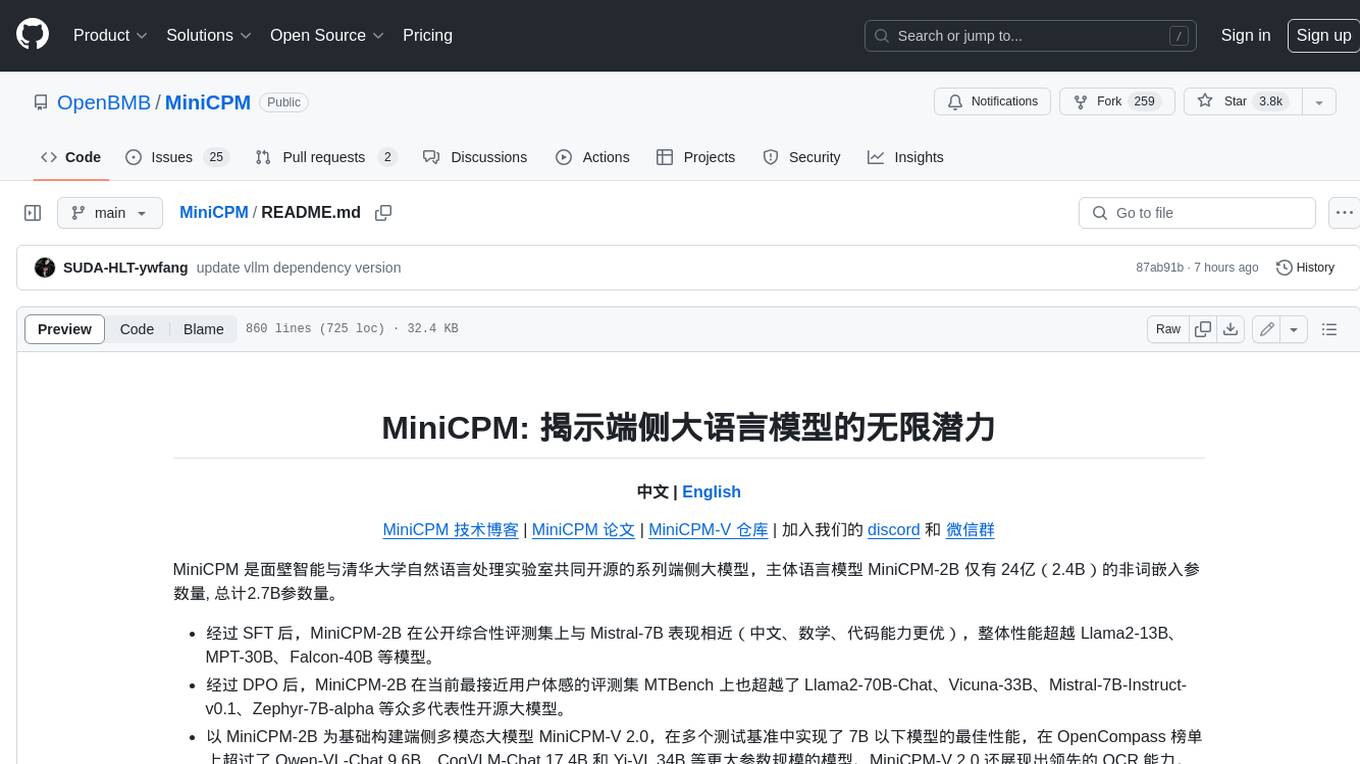
MiniCPM
MiniCPM is a series of open-source large models on the client side jointly developed by Face Intelligence and Tsinghua University Natural Language Processing Laboratory. The main language model MiniCPM-2B has only 2.4 billion (2.4B) non-word embedding parameters, with a total of 2.7B parameters. - After SFT, MiniCPM-2B performs similarly to Mistral-7B on public comprehensive evaluation sets (better in Chinese, mathematics, and code capabilities), and outperforms models such as Llama2-13B, MPT-30B, and Falcon-40B overall. - After DPO, MiniCPM-2B also surpasses many representative open-source large models such as Llama2-70B-Chat, Vicuna-33B, Mistral-7B-Instruct-v0.1, and Zephyr-7B-alpha on the current evaluation set MTBench, which is closest to the user experience. - Based on MiniCPM-2B, a multi-modal large model MiniCPM-V 2.0 on the client side is constructed, which achieves the best performance of models below 7B in multiple test benchmarks, and surpasses larger parameter scale models such as Qwen-VL-Chat 9.6B, CogVLM-Chat 17.4B, and Yi-VL 34B on the OpenCompass leaderboard. MiniCPM-V 2.0 also demonstrates leading OCR capabilities, approaching Gemini Pro in scene text recognition capabilities. - After Int4 quantization, MiniCPM can be deployed and inferred on mobile phones, with a streaming output speed slightly higher than human speech speed. MiniCPM-V also directly runs through the deployment of multi-modal large models on mobile phones. - A single 1080/2080 can efficiently fine-tune parameters, and a single 3090/4090 can fully fine-tune parameters. A single machine can continuously train MiniCPM, and the secondary development cost is relatively low.
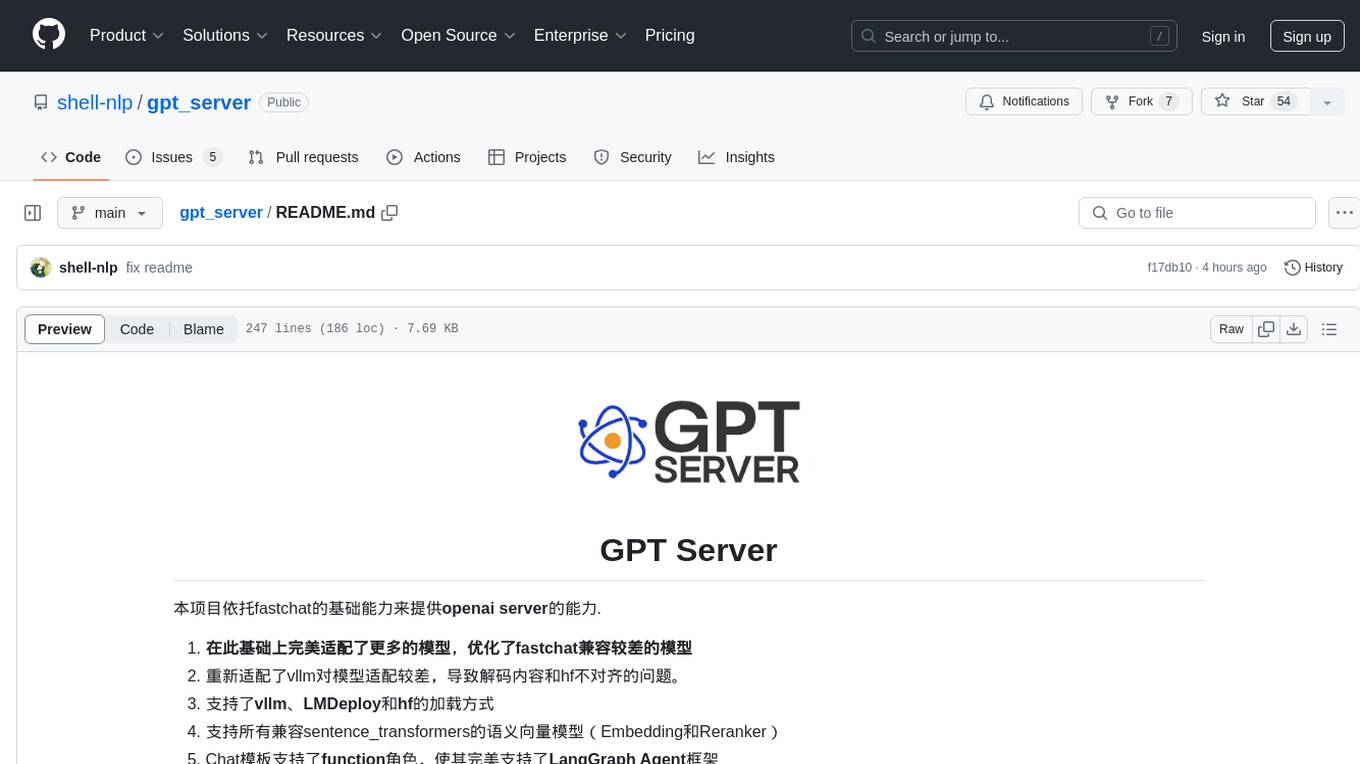
gpt_server
The GPT Server project leverages the basic capabilities of FastChat to provide the capabilities of an openai server. It perfectly adapts more models, optimizes models with poor compatibility in FastChat, and supports loading vllm, LMDeploy, and hf in various ways. It also supports all sentence_transformers compatible semantic vector models, including Chat templates with function roles, Function Calling (Tools) capability, and multi-modal large models. The project aims to reduce the difficulty of model adaptation and project usage, making it easier to deploy the latest models with minimal code changes.
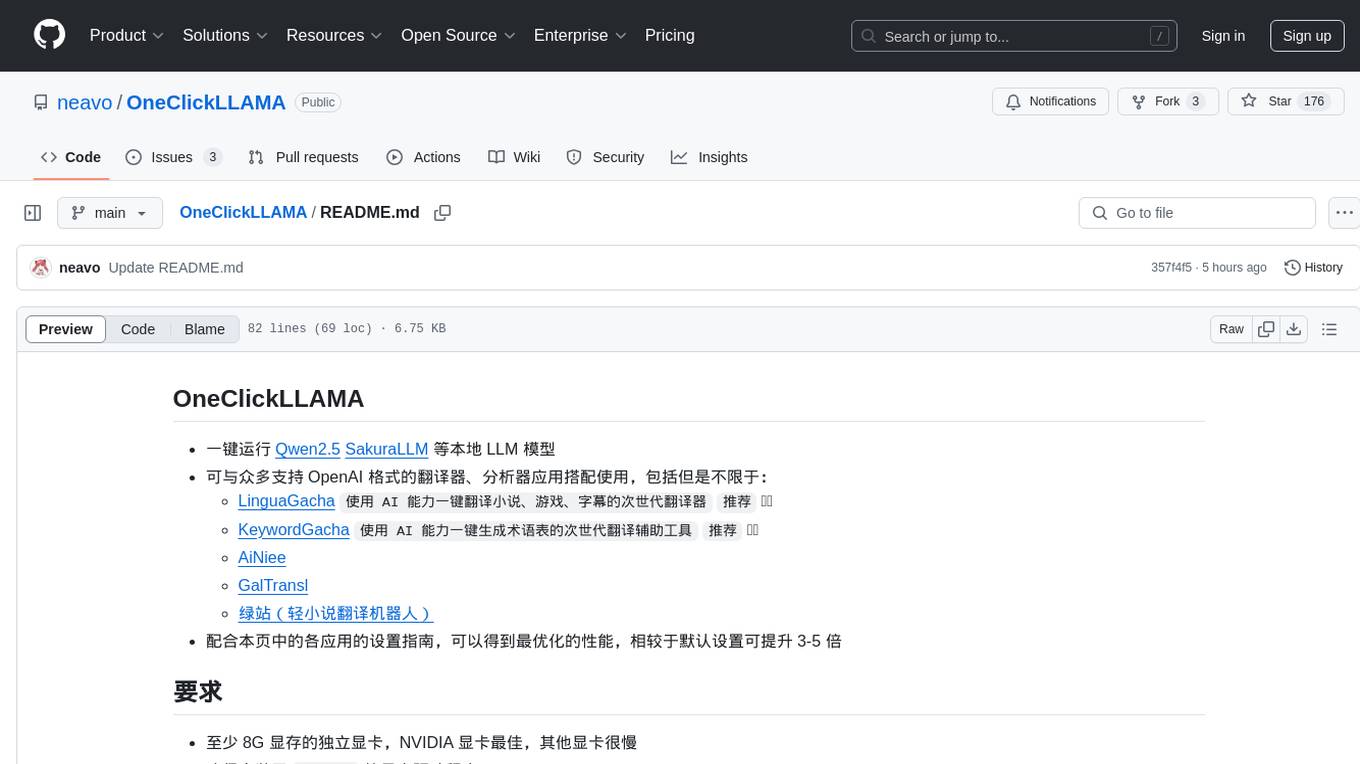
OneClickLLAMA
OneClickLLAMA is a tool designed to run local LLM models such as Qwen2.5 and SakuraLLM with ease. It can be used in conjunction with various OpenAI format translators and analyzers, including LinguaGacha and KeywordGacha. By following the setup guides provided on the page, users can optimize performance and achieve a 3-5 times speed improvement compared to default settings. The tool requires a minimum of 8GB dedicated graphics memory, preferably NVIDIA, and the latest version of graphics drivers installed. Users can download the tool from the release page, choose the appropriate model based on usage and memory size, and start the tool by selecting the corresponding launch script.
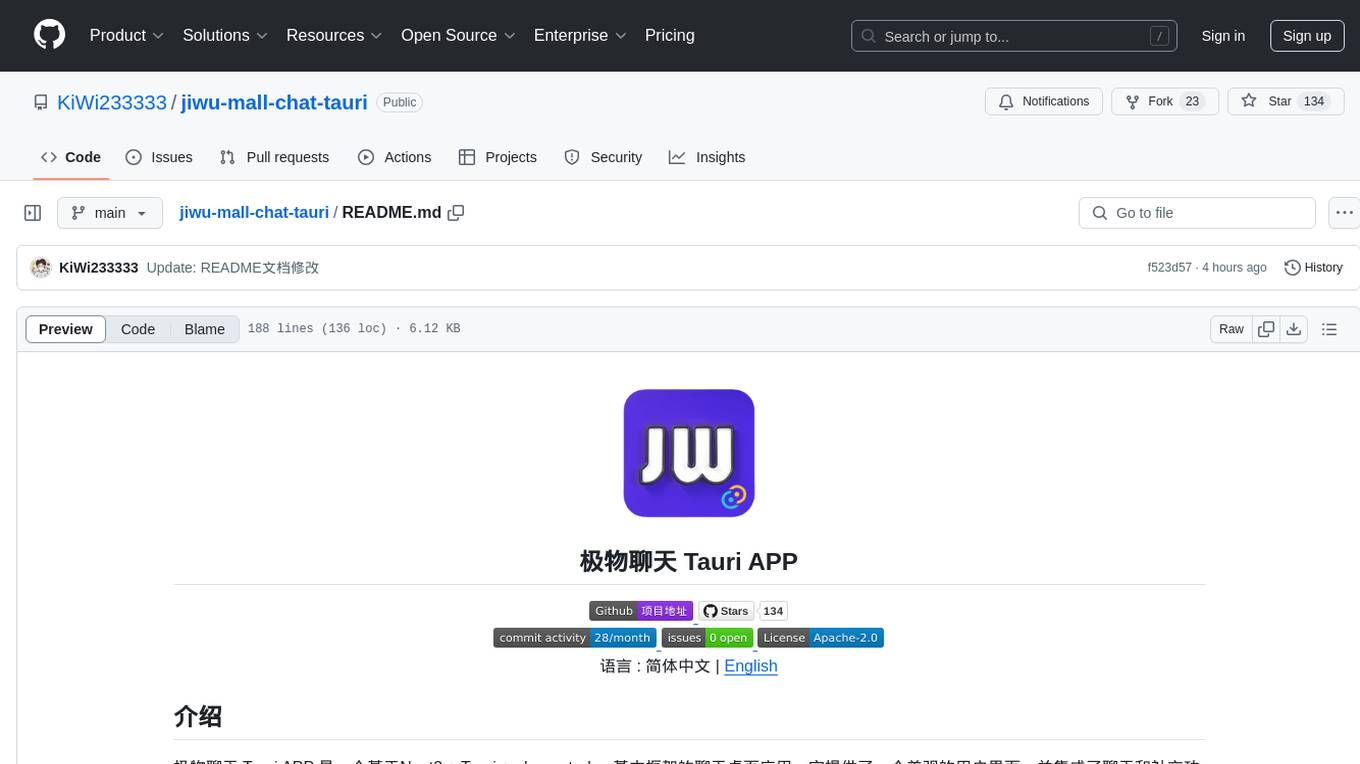
jiwu-mall-chat-tauri
Jiwu Chat Tauri APP is a desktop chat application based on Nuxt3 + Tauri + Element Plus framework. It provides a beautiful user interface with integrated chat and social functions. It also supports AI shopping chat and global dark mode. Users can engage in real-time chat, share updates, and interact with AI customer service through this application.

Langchain-Chatchat
LangChain-Chatchat is an open-source, offline-deployable retrieval-enhanced generation (RAG) large model knowledge base project based on large language models such as ChatGLM and application frameworks such as Langchain. It aims to establish a knowledge base Q&A solution that is friendly to Chinese scenarios, supports open-source models, and can run offline.
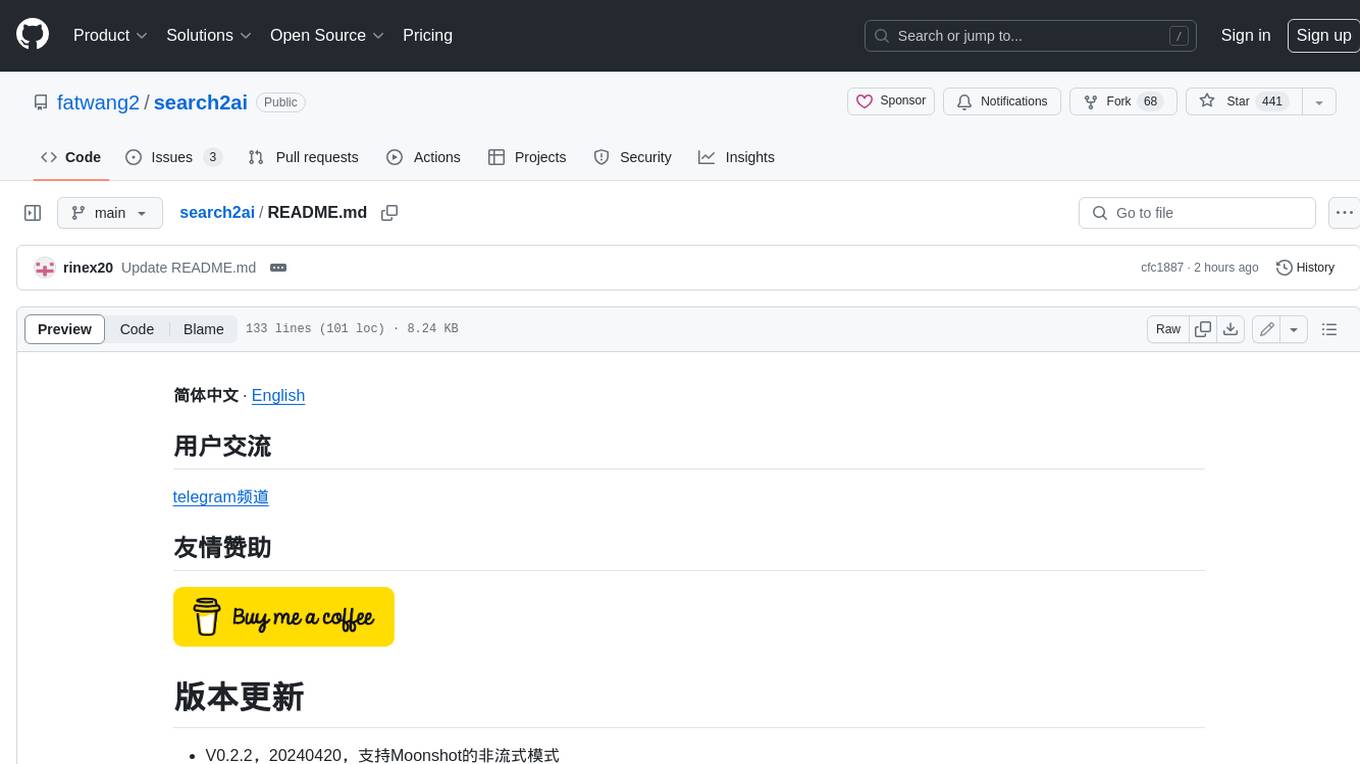
search2ai
S2A allows your large model API to support networking, searching, news, and web page summarization. It currently supports OpenAI, Gemini, and Moonshot (non-streaming). The large model will determine whether to connect to the network based on your input, and it will not connect to the network for searching every time. You don't need to install any plugins or replace keys. You can directly replace the custom address in your commonly used third-party client. You can also deploy it yourself, which will not affect other functions you use, such as drawing and voice.
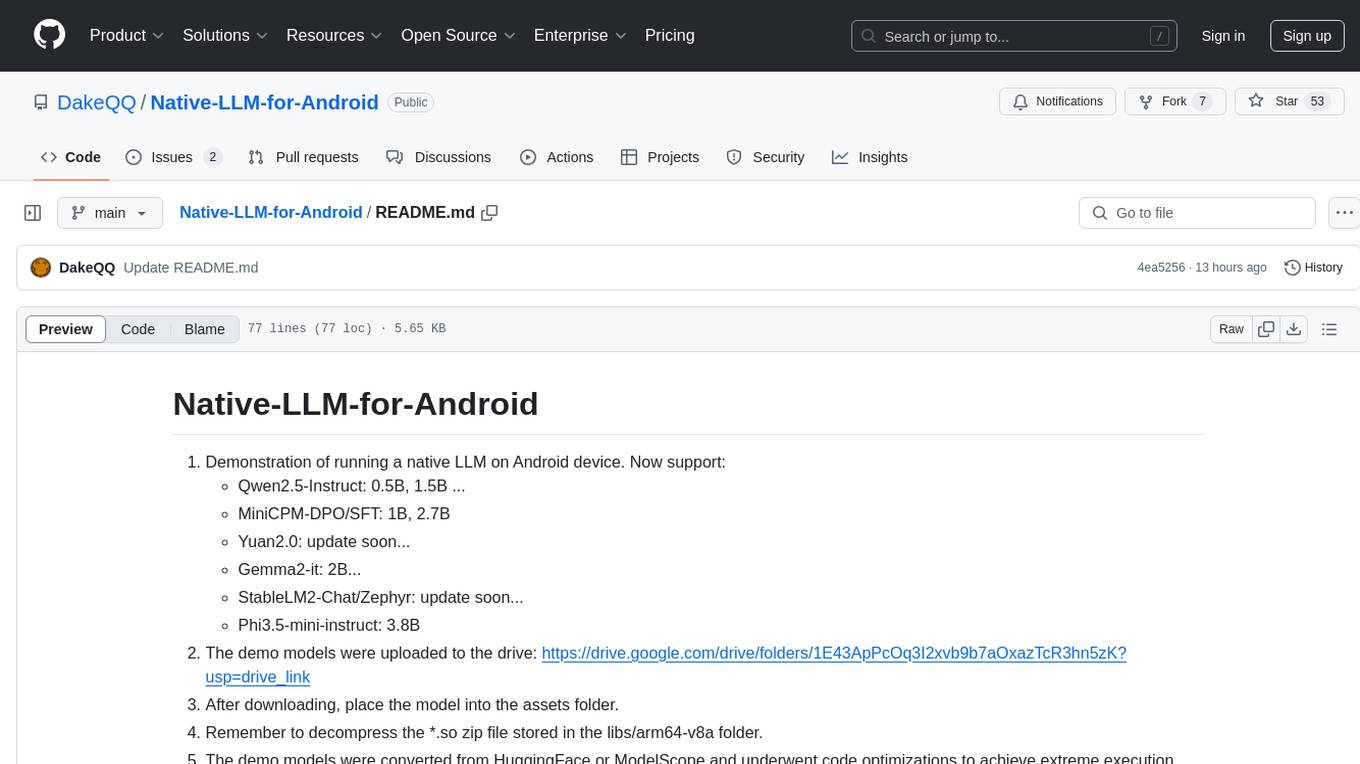
Native-LLM-for-Android
This repository provides a demonstration of running a native Large Language Model (LLM) on Android devices. It supports various models such as Qwen2.5-Instruct, MiniCPM-DPO/SFT, Yuan2.0, Gemma2-it, StableLM2-Chat/Zephyr, and Phi3.5-mini-instruct. The demo models are optimized for extreme execution speed after being converted from HuggingFace or ModelScope. Users can download the demo models from the provided drive link, place them in the assets folder, and follow specific instructions for decompression and model export. The repository also includes information on quantization methods and performance benchmarks for different models on various devices.

VideoCaptioner
VideoCaptioner is a video subtitle processing assistant based on a large language model (LLM), supporting speech recognition, subtitle segmentation, optimization, translation, and full-process handling. It is user-friendly and does not require high configuration, supporting both network calls and local offline (GPU-enabled) speech recognition. It utilizes a large language model for intelligent subtitle segmentation, correction, and translation, providing stunning subtitles for videos. The tool offers features such as accurate subtitle generation without GPU, intelligent segmentation and sentence splitting based on LLM, AI subtitle optimization and translation, batch video subtitle synthesis, intuitive subtitle editing interface with real-time preview and quick editing, and low model token consumption with built-in basic LLM model for easy use.
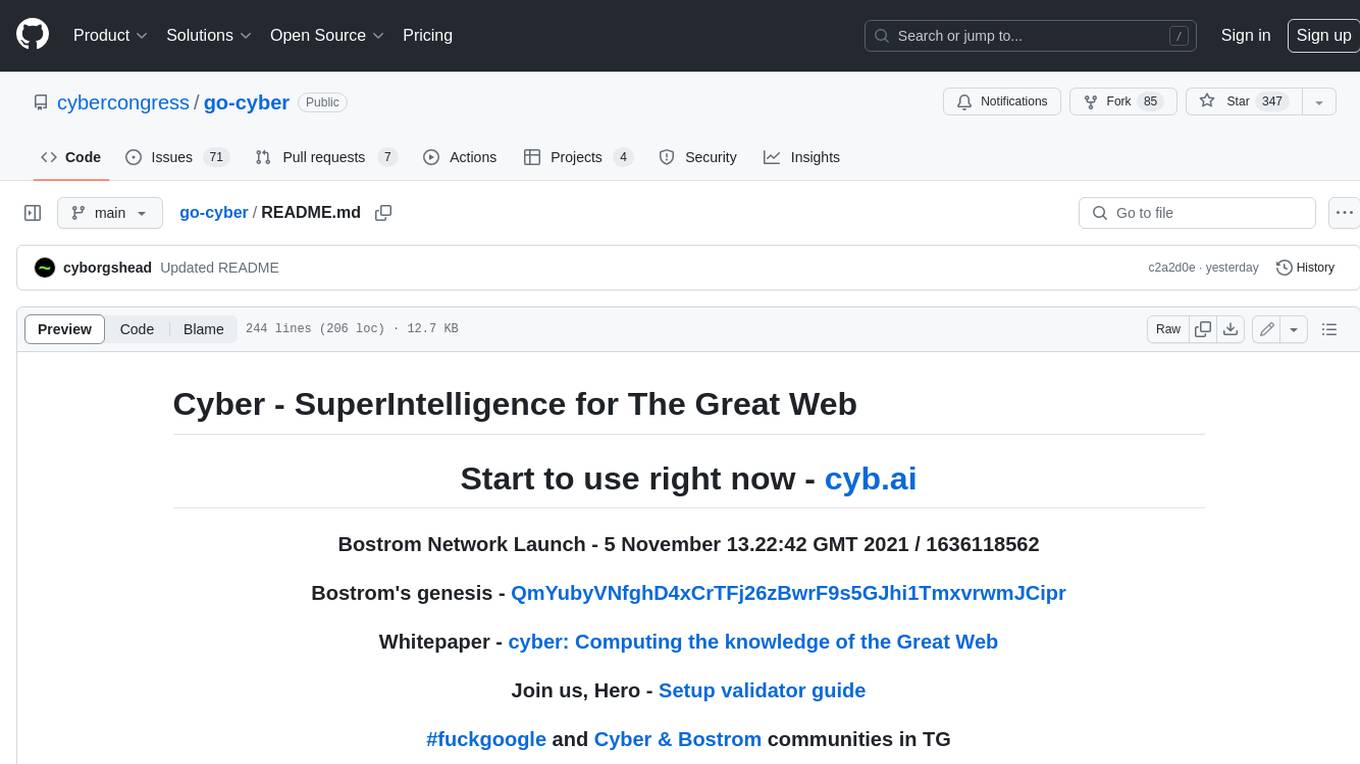
go-cyber
Cyber is a superintelligence protocol that aims to create a decentralized and censorship-resistant internet. It uses a novel consensus mechanism called CometBFT and a knowledge graph to store and process information. Cyber is designed to be scalable, secure, and efficient, and it has the potential to revolutionize the way we interact with the internet.
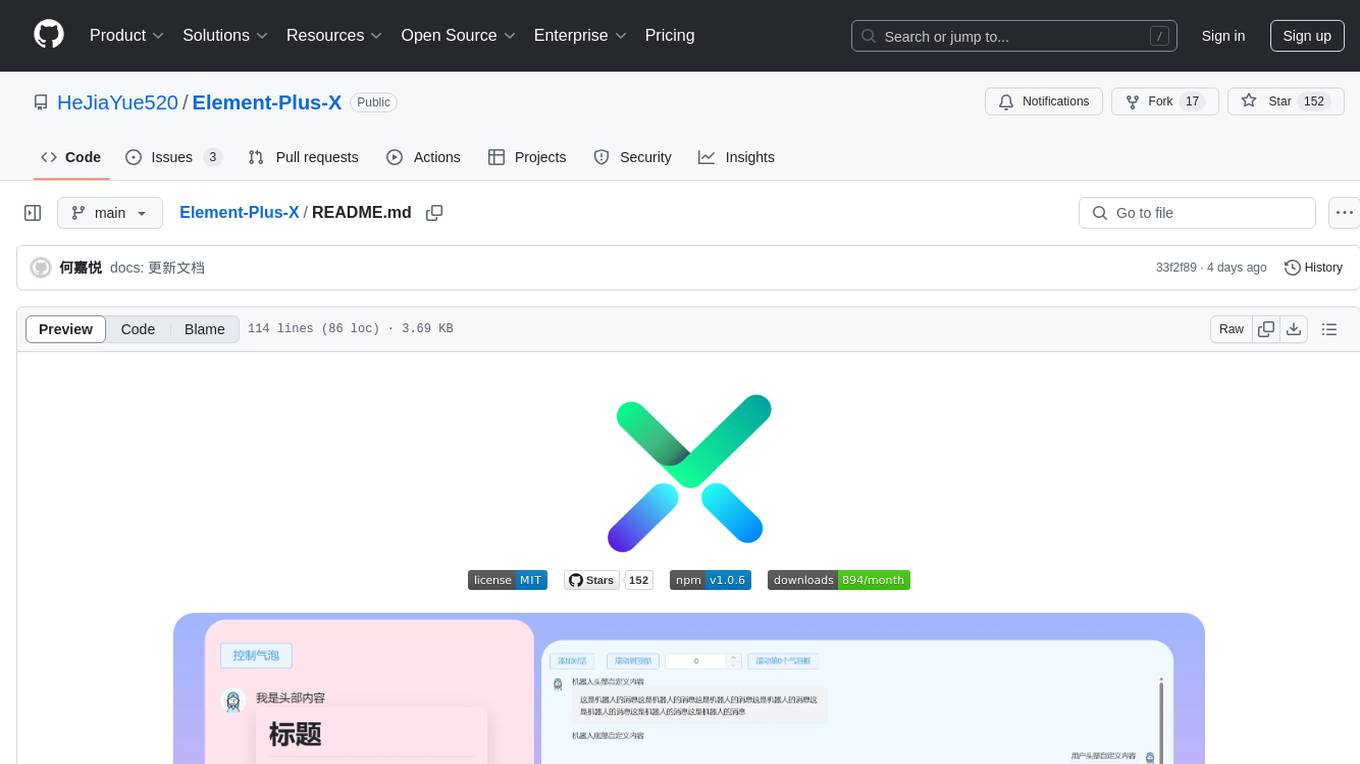
Element-Plus-X
Element-Plus-X is an out-of-the-box enterprise-level AI component library based on Vue 3 + Element-Plus. It features built-in scenario components such as chatbots and voice interactions, seamless integration with zero configuration based on Element-Plus design system, and support for on-demand loading with Tree Shaking optimization.
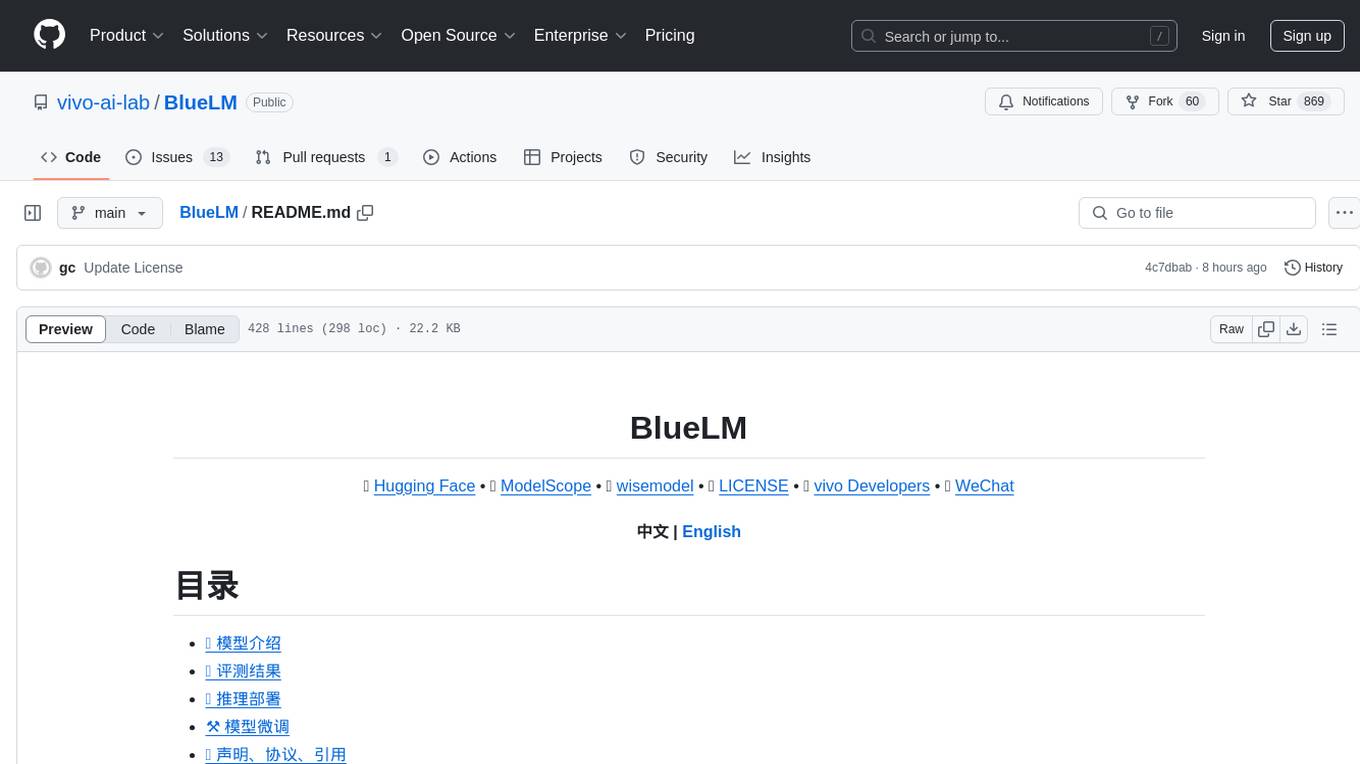
BlueLM
BlueLM is a large-scale pre-trained language model developed by vivo AI Global Research Institute, featuring 7B base and chat models. It includes high-quality training data with a token scale of 26 trillion, supporting both Chinese and English languages. BlueLM-7B-Chat excels in C-Eval and CMMLU evaluations, providing strong competition among open-source models of similar size. The models support 32K long texts for better context understanding while maintaining base capabilities. BlueLM welcomes developers for academic research and commercial applications.
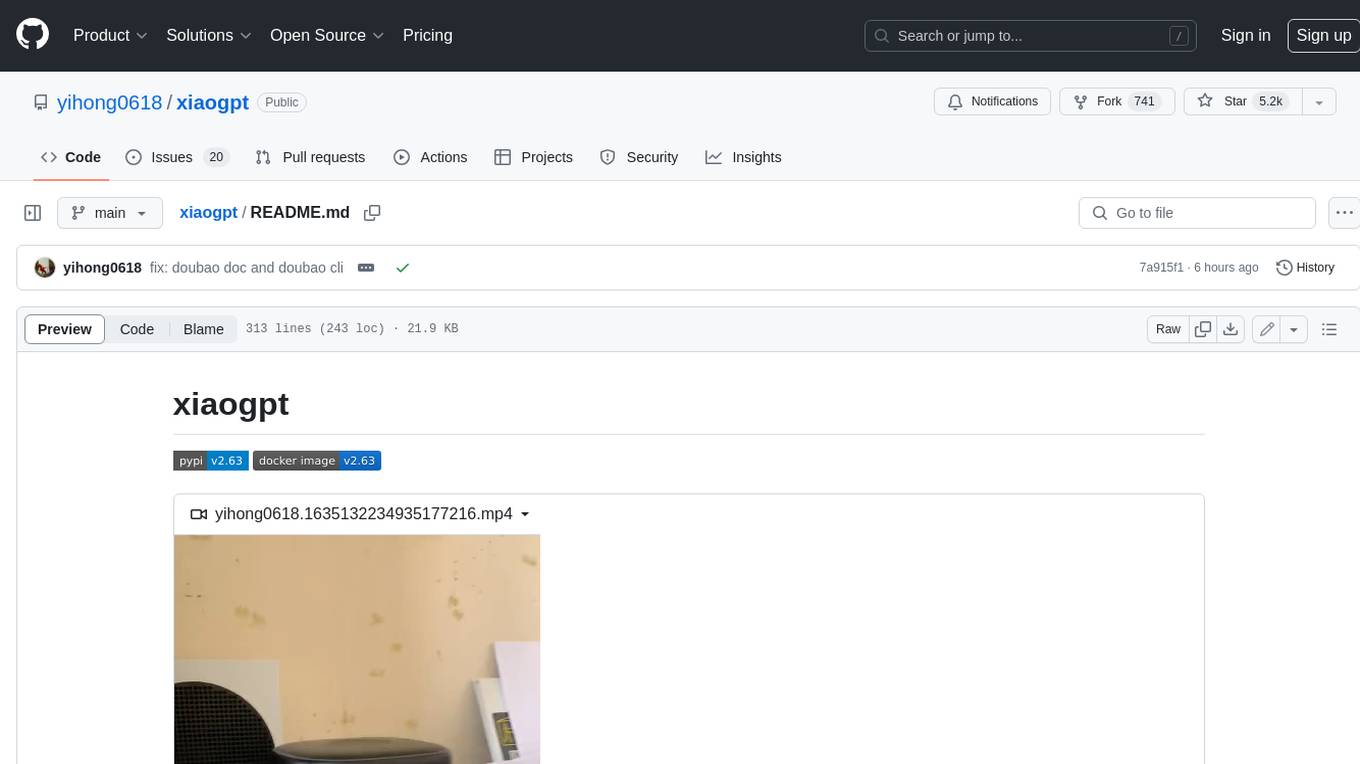
xiaogpt
xiaogpt is a tool that allows you to play ChatGPT and other LLMs with Xiaomi AI Speaker. It supports ChatGPT, New Bing, ChatGLM, Gemini, Doubao, and Tongyi Qianwen. You can use it to ask questions, get answers, and have conversations with AI assistants. xiaogpt is easy to use and can be set up in a few minutes. It is a great way to experience the power of AI and have fun with your Xiaomi AI Speaker.
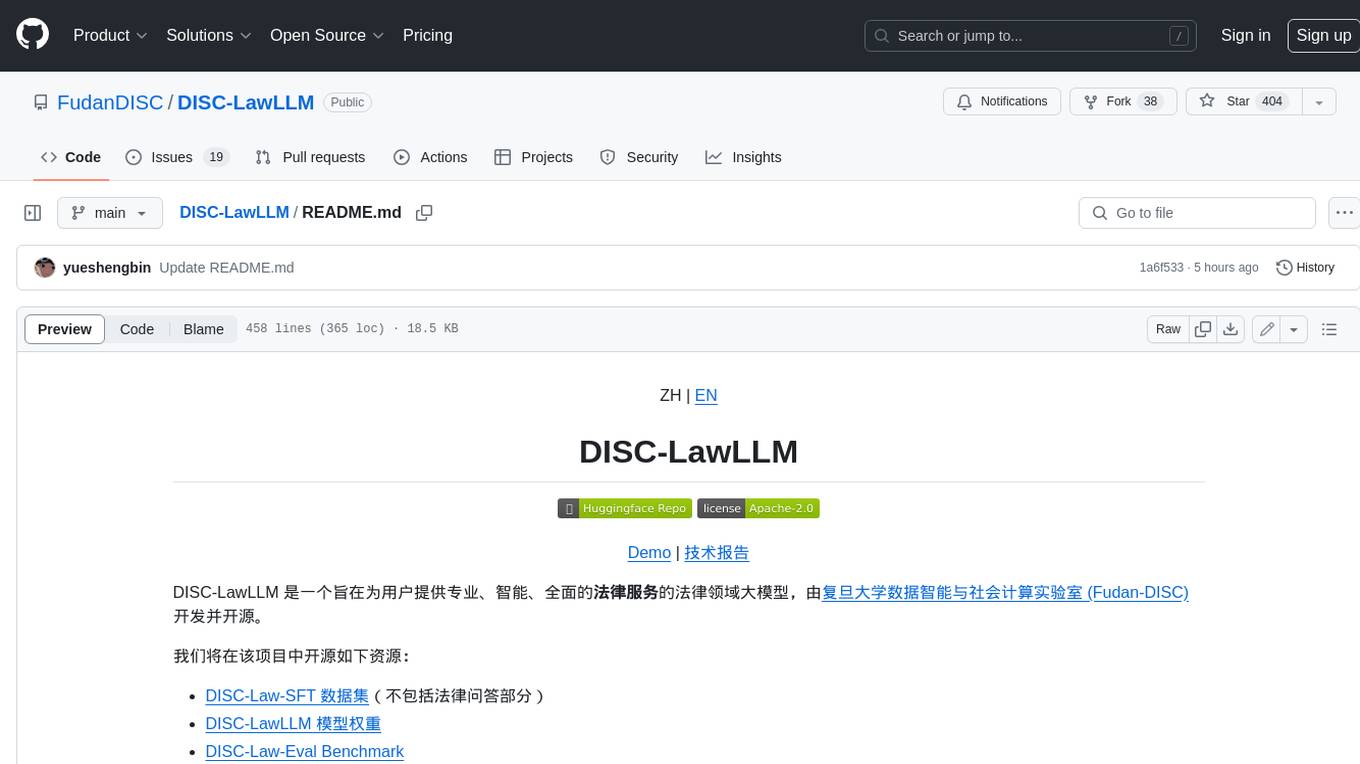
DISC-LawLLM
DISC-LawLLM is a legal domain large model that aims to provide professional, intelligent, and comprehensive **legal services** to users. It is developed and open-sourced by the Data Intelligence and Social Computing Lab (Fudan-DISC) at Fudan University.
For similar tasks

XiaoXinAir14IML_2019_hackintosh
XiaoXinAir14IML_2019_hackintosh is a repository dedicated to enabling macOS installation on Lenovo XiaoXin Air-14 IML 2019 laptops. The repository provides detailed information on the hardware specifications, supported systems, BIOS versions, related models, installation methods, updates, patches, and recommended settings. It also includes tools and guides for BIOS modifications, enabling high-resolution display settings, Bluetooth synchronization between macOS and Windows 10, voltage adjustments for efficiency, and experimental support for YogaSMC. The repository offers solutions for various issues like sleep support, sound card emulation, and battery information. It acknowledges the contributions of developers and tools like OpenCore, itlwm, VoodooI2C, and ALCPlugFix.
For similar jobs

tt-metal
TT-NN is a python & C++ Neural Network OP library. It provides a low-level programming model, TT-Metalium, enabling kernel development for Tenstorrent hardware.
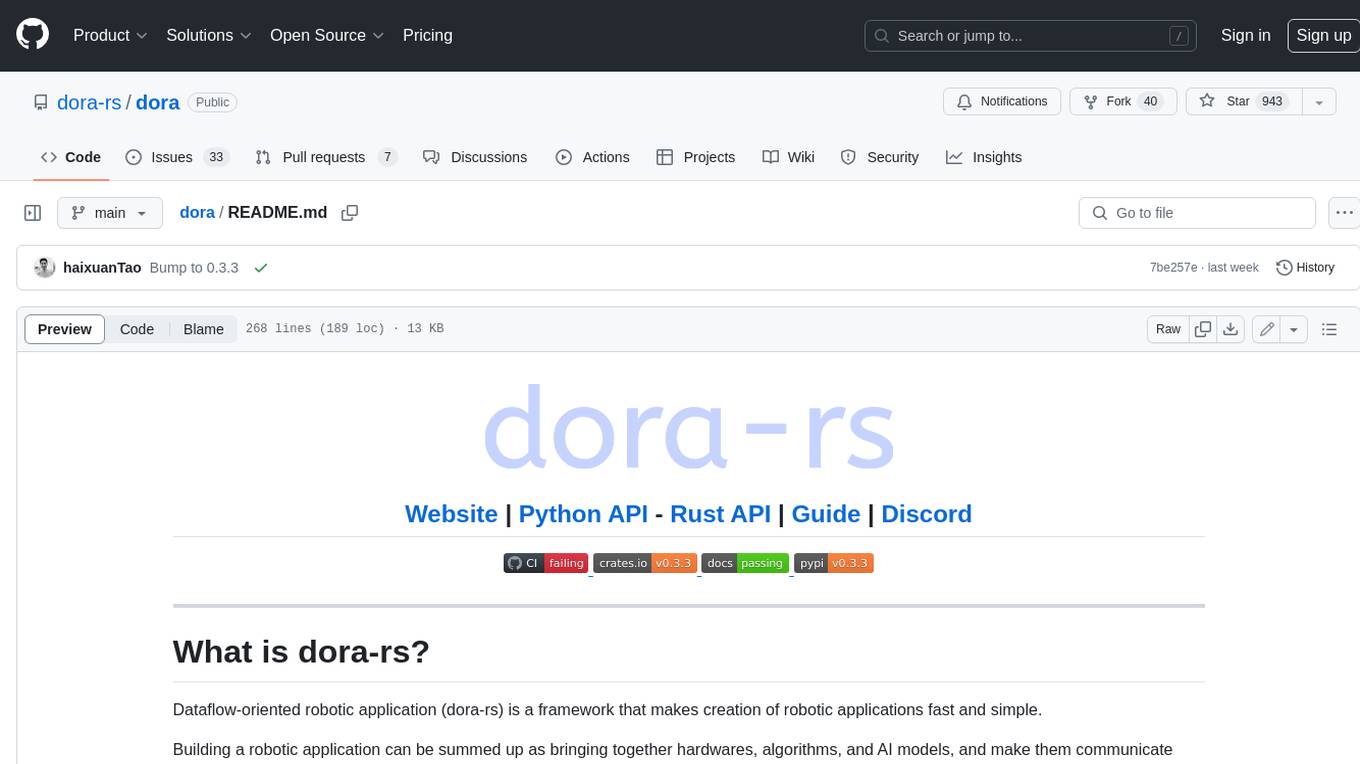
dora
Dataflow-oriented robotic application (dora-rs) is a framework that makes creation of robotic applications fast and simple. Building a robotic application can be summed up as bringing together hardwares, algorithms, and AI models, and make them communicate with each others. At dora-rs, we try to: make integration of hardware and software easy by supporting Python, C, C++, and also ROS2. make communication low latency by using zero-copy Arrow messages. dora-rs is still experimental and you might experience bugs, but we're working very hard to make it stable as possible.
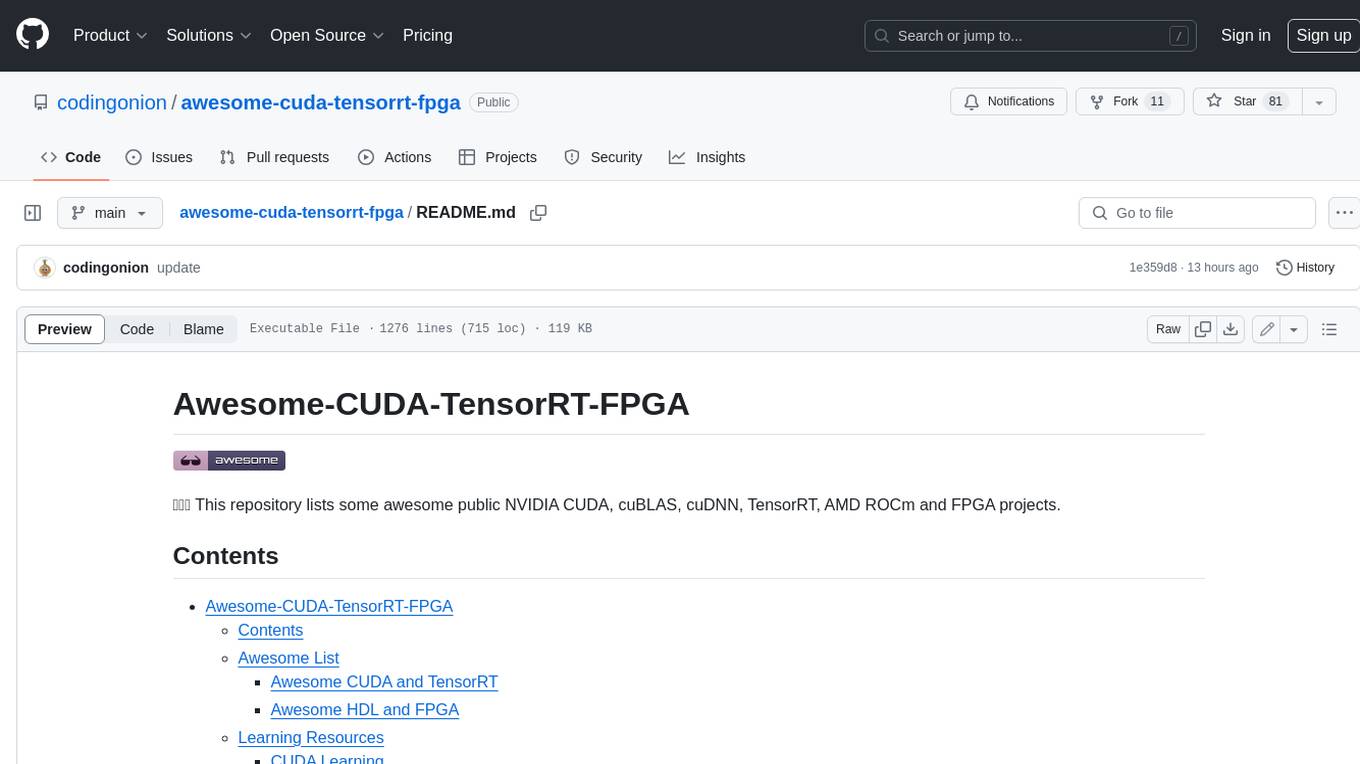
awesome-cuda-tensorrt-fpga
Okay, here is a JSON object with the requested information about the awesome-cuda-tensorrt-fpga repository:
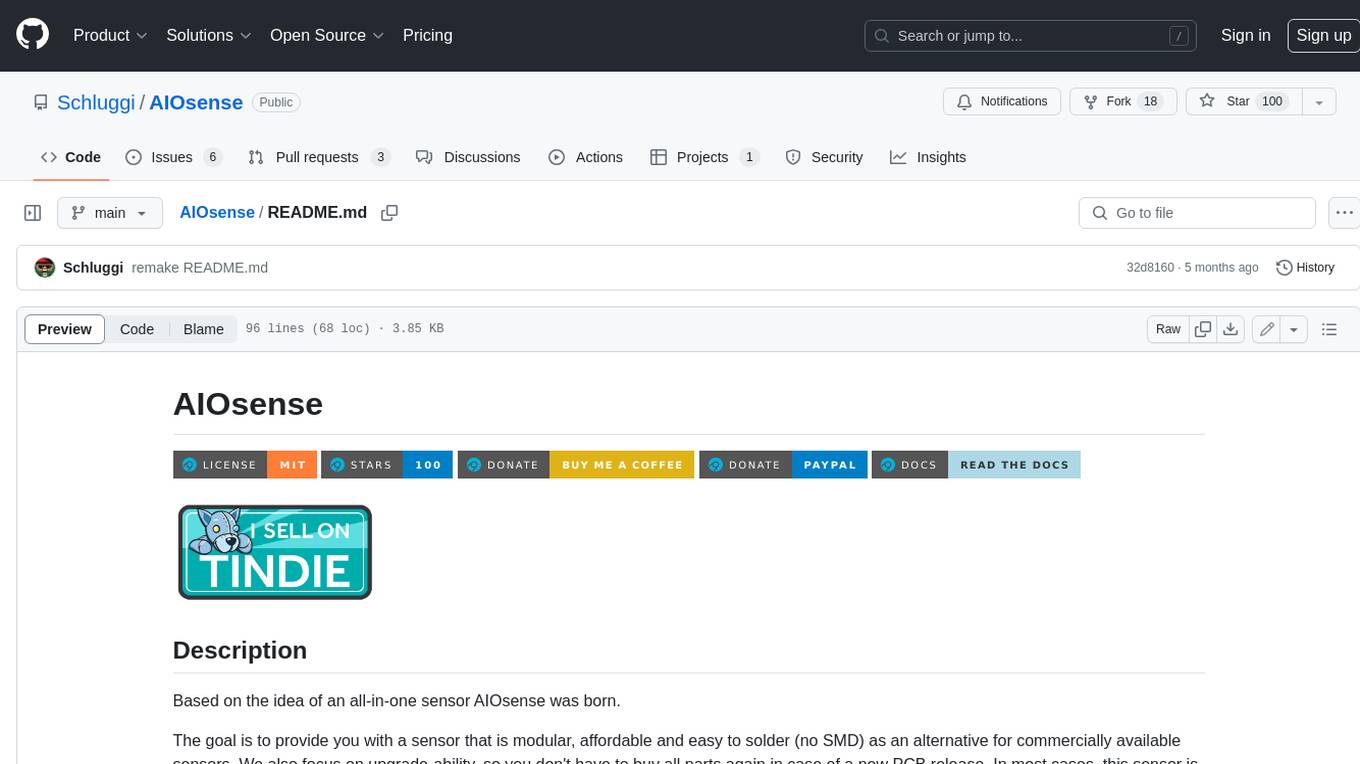
AIOsense
AIOsense is an all-in-one sensor that is modular, affordable, and easy to solder. It is designed to be an alternative to commercially available sensors and focuses on upgradeability. AIOsense is cheaper and better than most commercial sensors and supports a variety of sensors and modules, including: - (RGB)-LED - Barometer - Breath VOC equivalent - Buzzer / Beeper - CO² equivalent - Humidity sensor - Light / Illumination sensor - PIR motion sensor - Temperature sensor - mmWave / Radar sensor Upcoming features include full voice assistant support, microphone, and speaker. All supported sensors & modules are listed in the documentation. AIOsense has a low power consumption, with an idle power consumption of 0.45W / 0.09A on a fully equipped board. Without a mmWave sensor, the idle power consumption is around 0.11W / 0.02A. To get started with AIOsense, you can refer to the documentation. If you have any questions, you can open an issue.
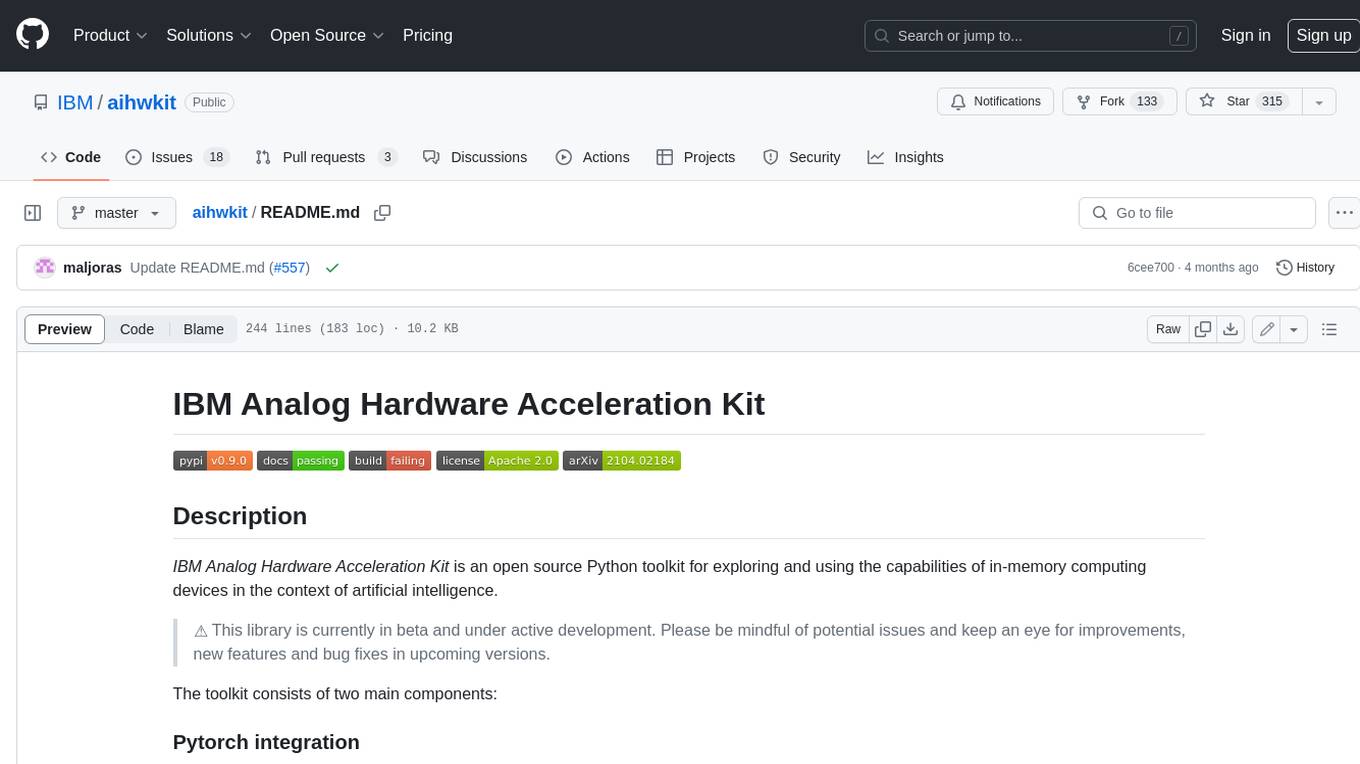
aihwkit
The IBM Analog Hardware Acceleration Kit is an open-source Python toolkit for exploring and using the capabilities of in-memory computing devices in the context of artificial intelligence. It consists of two main components: Pytorch integration and Analog devices simulator. The Pytorch integration provides a series of primitives and features that allow using the toolkit within PyTorch, including analog neural network modules, analog training using torch training workflow, and analog inference using torch inference workflow. The Analog devices simulator is a high-performant (CUDA-capable) C++ simulator that allows for simulating a wide range of analog devices and crossbar configurations by using abstract functional models of material characteristics with adjustable parameters. Along with the two main components, the toolkit includes other functionalities such as a library of device presets, a module for executing high-level use cases, a utility to automatically convert a downloaded model to its equivalent Analog model, and integration with the AIHW Composer platform. The toolkit is currently in beta and under active development, and users are advised to be mindful of potential issues and keep an eye for improvements, new features, and bug fixes in upcoming versions.
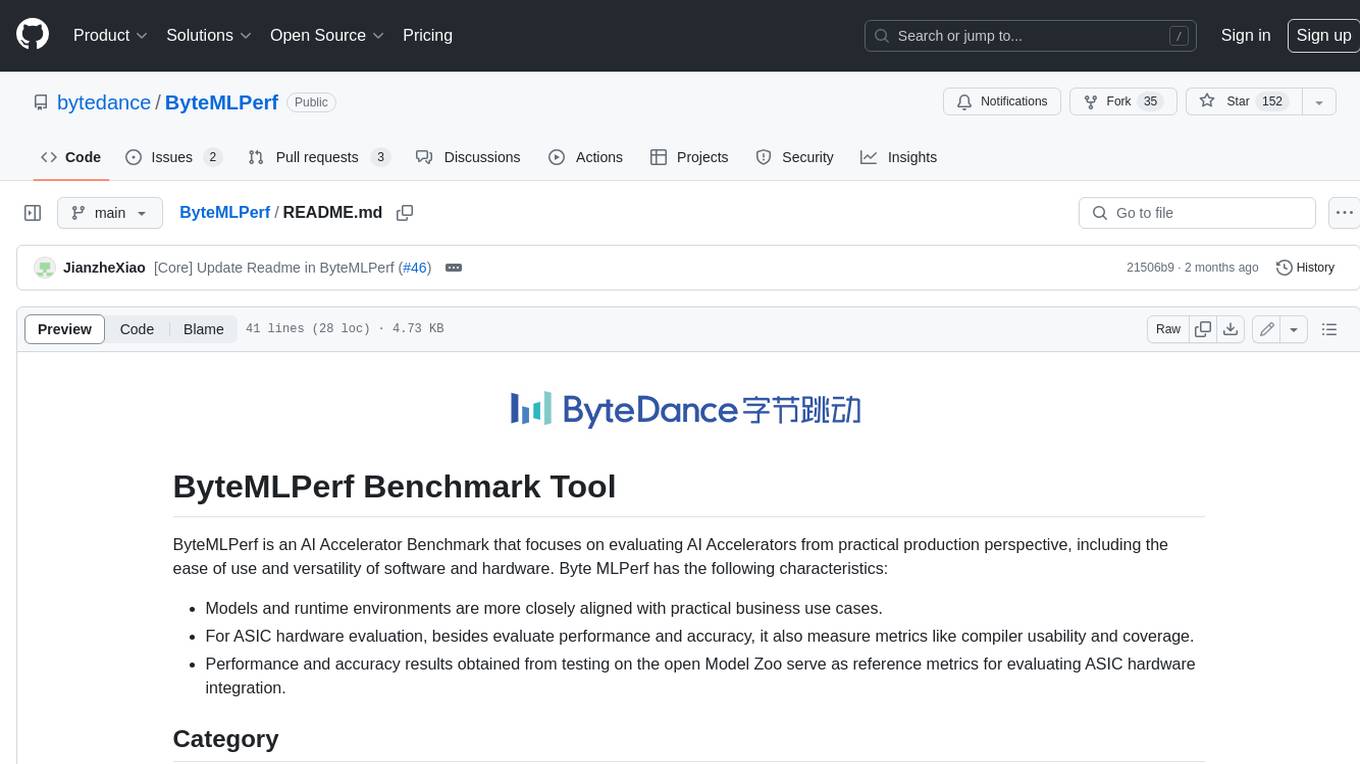
ByteMLPerf
ByteMLPerf is an AI Accelerator Benchmark that focuses on evaluating AI Accelerators from a practical production perspective, including the ease of use and versatility of software and hardware. Byte MLPerf has the following characteristics: - Models and runtime environments are more closely aligned with practical business use cases. - For ASIC hardware evaluation, besides evaluate performance and accuracy, it also measure metrics like compiler usability and coverage. - Performance and accuracy results obtained from testing on the open Model Zoo serve as reference metrics for evaluating ASIC hardware integration.

GlaDOS
This project aims to create a real-life version of GLaDOS, an aware, interactive, and embodied AI entity. It involves training a voice generator, developing a 'Personality Core,' implementing a memory system, providing vision capabilities, creating 3D-printable parts, and designing an animatronics system. The software architecture focuses on low-latency voice interactions, utilizing a circular buffer for data recording, text streaming for quick transcription, and a text-to-speech system. The project also emphasizes minimal dependencies for running on constrained hardware. The hardware system includes servo- and stepper-motors, 3D-printable parts for GLaDOS's body, animations for expression, and a vision system for tracking and interaction. Installation instructions cover setting up the TTS engine, required Python packages, compiling llama.cpp, installing an inference backend, and voice recognition setup. GLaDOS can be run using 'python glados.py' and tested using 'demo.ipynb'.

OpenGlass
OpenGlass is an open-source project that allows users to transform any regular glasses into smart glasses using affordable off-the-shelf components. With a cost of less than $25, users can enhance their glasses to record their daily activities, recognize people, identify objects, translate text, and more. The project provides detailed instructions on hardware setup and software installation, making it accessible for DIY enthusiasts and tech enthusiasts alike. By following the steps outlined in the repository, users can create their own smart glasses and explore various functionalities offered by the project.